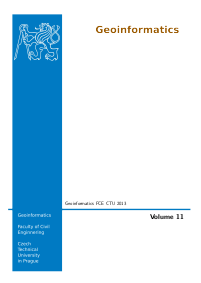Extension of mathematical background for Nearest Neighbour Analysis in three-dimensional space
DOI:
https://doi.org/10.14311/gi.11.2Keywords:
3D GIS, spatial analysis, Nearest Neighbour AnalysisAbstract
Proceeding deals with development and testing of the module for GRASS GIS [1], based on Nearest Neighbour Analysis. This method can be useful for assessing whether points located in area of interest are distributed randomly, in clusters or separately. The main principle of the method consists of comparing observed average distance between the nearest neighbours r A to average distance between the nearest neighbours r E that is expected in case of randomly distributed points. The result should be statistically tested. The method for two- or three-dimensional space differs in way how to compute r E . Proceeding also describes extension of mathematical background deriving standard deviation of r E , needed in statistical test of analysis result. As disposition of phenomena (e.g. distribution of birds’ nests or plant species) and test results suggest, anisotropic function would repre- sent relationships between points in three-dimensional space better than isotropic function that was used in this work.References
GRASS Development Team (2013): Geographic Resources Analysis Support System (GRASS) Software [computer software]. Open Source Geospatial Foundation Project. Available at: http://grass.osgeo.org.
CLARK, P. J., EVANS, F. C. (2003): Distance to Nearest Neighbor as a Measure of Spatial Relationships in Populations. In Ecology [online]. Vol. 35, Is. 4. October 1954 [cit. 2013-03-21], pp. 445-453. Available at: https://courses.washington.edu/bio480/Week1-PAPER-Clark_and_Evans1954.pdf. ISSN 0012-9658.
HERTZ, P. (1909): Über den geigenseitigen durchschnittlichen Abstand von Punkten, die mit bekannter mittlerer Dichte im Raume angeordnet sind. In Mathematische Annalen, 67: 387-398. According to: CLARK, P. J., EVANS, F. C. (2003). Distance to Nearest Neighbor as a Measure of Spatial Relationships in Populations. In Ecology [online]. Vol. 35, Is. 4. October 1954 [cit. 2013-03-21], pp. 445-453. Available at: https://courses.washington.edu/bio480/Week1-PAPER-Clark_and_Evans1954.pdf. ISSN 0012-9658.
CHANDRASEKHAR, S. (1943): The Law of Distribution of the Nearest Neighbor in a Random Distribution of Particles. In Reviews of Modern Physics. Stochastic Problems in Physics and Astronomy. Vol. 15, 1-89, 1943 [cit. 2013-03-21], pp. 86-87. Available at: http://rmp.aps.org/abstract/RMP/v15/i1/p1_1. ISSN 1539-0756.
WEISSTEIN, E. W. (2013): Gamma Function. In MathWorld. A Wolfram Web Resource [online]. 201 [cit. 2013-03-21]. Available at: http://mathworld.wolfram.com/GammaFunction.html.
ESRI (2013): Average Nearest Neighbor [computer software]. In ArcGIS Desktop: Release 10.1, Spatial Statistics Toolbox [cit. 2013-05-14]. Redlands, CA: Environmental Systems Research Institute.
HUGHES, I. G., HASE, T. P. A. (2010): Measurements and their Uncertainities : A practical Guide to Modern Analysis. 1. edition. New York : Oxford University Press Inc., New York, 2010. 136 p. ISBN 978-0-19-956633-4.
ESRI (2012): What is a z-score? What is a p-value? In ArcGIS Help 10.1 [online]. 2012 [cit. 2013-03-21]. Available at: http://resources.arcgis.com/en/help/main/10.1/index.html#/What_is_a_z_score_What_is_a_p_value/005p00000006000000/.
KARPÍŠEK, Z. (2004): Statistické tabulky [Statistical tables]. Institute of Mathematics FSI VUT in Brno [online]. 2004 [cit. 2013-06-03]. Available at: http://mathonline.fme.vutbr.cz/default.aspx?section=2&article=121&highlighttext=tabulky
ESRI (2013). ArcGIS Desktop: Release 10.1. Redlands, CA: Environmental Systems Research Institute.
ESRI (2013): Average Nearest Neighbor (Spatial Statistics). In ArcGIS Help 10.1 [online]. 2013 [cit. 2013-05-14]. Available at: http://resources.arcgis.com/en/help/main/10.1/index.html#//005p00000008000000
NELSON, M. (2007): The Convex Hull. In Computer Science, Web Articles [online]. 2007 [cit. 2013-05-30]. Available at: http://marknelson.us/2007/08/22/convex/
AIME, A., NETELER, M., DUCKE, B., LANDA, M. (2010): v.hull [computer soft- ware]. In Geographic Resources Analysis Support System (GRASS) Software. Available at: http://trac.osgeo.org/grass/wiki/DownloadSource#GRASS7
Wolfram Research, Inc. (2008). Mathematica [computer software]. Version 7.0. Champaign : Wolfram Research, Inc.
MathWorks, Inc. (2010). MATLAB [computer software]. Version 7.11.0. Natick, Massachusetts: The MathWorks, Inc.
McCAULEY, J. D., LANDA, M. (2010): v.random [computer software]. In Geographic Resources Analysis Support System (GRASS) Software. Available at: http://trac.osgeo.org/grass/wiki/DownloadSource#GRASS7
VALLO, D. et al. (2012): Geometria telies. . . všeobecne a pútavo [Geometry of bodies. . . in general and grippingly]. Faculty of Natural Sciences, Constantine the Philosopher University in Nitra [online]. 2012 [cit. 2013-05-30]. Available at: http://www.km.fpv.ukf.sk/admin/upload_pdf/20121108_145712__0.pdf. ISBN 978-80-558-0106-3.
ZEYL, D. (2013) Plato’s Timaeus. In The Stanford Encyclopedia of Philosophy (Spring 2013 Edition) [online], Edward N. Zalta (ed.). [cit. 2013-05-30].Available at: http://plato.stanford.edu/archives/spr2013/entries/plato-timaeus/.
WEISSTEIN, E. W. (2013): Archimedean Solid. In MathWorld. A Wolfram Web Resource [online]. 2013 [cit. 2013-05-30]. Available at: http://mathworld.wolfram.com/ArchimedeanSolid.html.
Downloads
Published
Issue
Section
License
- Authors retain copyright and grant the journal right of first publication with the work simultaneously licensed under a Creative Commons Attribution License that allows others to share the work with an acknowledgement of the work's authorship and initial publication in this journal.
- Authors are able to enter into separate, additional contractual arrangements for the non-exclusive distribution of the journal's published version of the work (e.g., post it to an institutional repository or publish it in a book), with an acknowledgement of its initial publication in this journal.
- Authors are permitted and encouraged to post their work online (e.g., in institutional repositories or on their website) prior to and during the submission process, as it can lead to productive exchanges, as well as earlier and greater citation of published work (See The Effect of Open Access).

